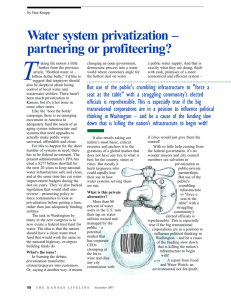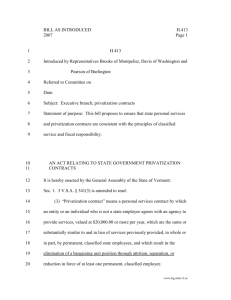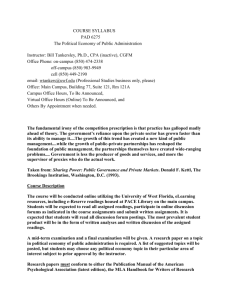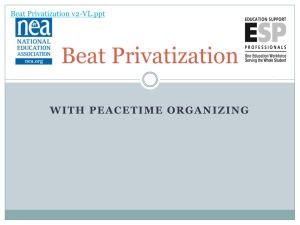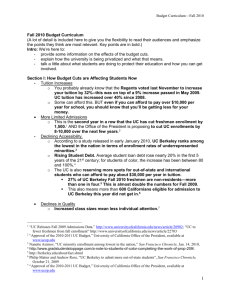Impact of Privatization on Sustainable Development
advertisement
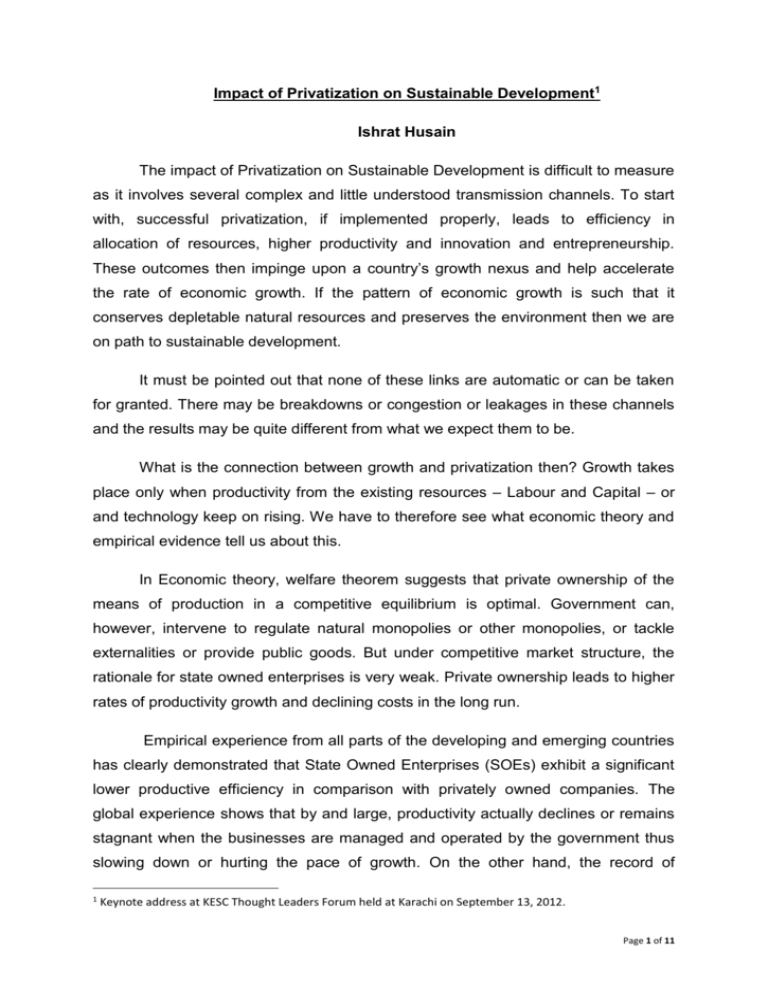
Impact of Privatization on Sustainable Development1 Ishrat Husain The impact of Privatization on Sustainable Development is difficult to measure as it involves several complex and little understood transmission channels. To start with, successful privatization, if implemented properly, leads to efficiency in allocation of resources, higher productivity and innovation and entrepreneurship. These outcomes then impinge upon a country’s growth nexus and help accelerate the rate of economic growth. If the pattern of economic growth is such that it conserves depletable natural resources and preserves the environment then we are on path to sustainable development. It must be pointed out that none of these links are automatic or can be taken for granted. There may be breakdowns or congestion or leakages in these channels and the results may be quite different from what we expect them to be. What is the connection between growth and privatization then? Growth takes place only when productivity from the existing resources – Labour and Capital – or and technology keep on rising. We have to therefore see what economic theory and empirical evidence tell us about this. In Economic theory, welfare theorem suggests that private ownership of the means of production in a competitive equilibrium is optimal. Government can, however, intervene to regulate natural monopolies or other monopolies, or tackle externalities or provide public goods. But under competitive market structure, the rationale for state owned enterprises is very weak. Private ownership leads to higher rates of productivity growth and declining costs in the long run. Empirical experience from all parts of the developing and emerging countries has clearly demonstrated that State Owned Enterprises (SOEs) exhibit a significant lower productive efficiency in comparison with privately owned companies. The global experience shows that by and large, productivity actually declines or remains stagnant when the businesses are managed and operated by the government thus slowing down or hurting the pace of growth. On the other hand, the record of 1 Keynote address at KESC Thought Leaders Forum held at Karachi on September 13, 2012. Page 1 of 11 privatization in the last three decades has been quite successful in raising productivity particularly in countries which have put in place strong regulatory mechanism and sound corporate governance. Despite this strong empirical evidence, the popular perception prevails that privatization is unfair, hurts the poor, the disenfranchised and the workers and benefits the already rich. Regulatory capture also remains a serious problem that puts the privatization process to risk. It must be conceded that privatization is not a panacea for all economic ills and under certain strategic considerations it is neither advisable nor desirable to resort to privatization. The hangover of the past in general and the lingering fascination for the socialist model among some of our intellectuals in particular continue to have a dominant influence on our thinking. Some of the resentment against private profit making is also quite legitimate and understandable. In the past, private entrepreneurs in Pakistan did not make ‘profits’ in the real economic sense of the word by earning a return on their investment in a competitive world. On the contrary, they earned ‘rents’ through the maze of permits, licences, preferred credit by the banks, subsidies, privileges, concessions and specific SROs granted to the favored few. Naturally when one sees people becoming rich not through the dint of their hard work and enterprise but by manipulation, back door entry, connections, reciprocity, paying bribes, adopting extra legal means, bypassing the established rules and laws, getting scarce foreign exchange quotas, evading taxes, defaulting on bank loans and rigging the markets etc., we should not be surprised to see the venom against the so called ‘private profits’. Therefore the role of the government policy and regulation in keeping these malpractices in check becomes critical. The Global Financial crisis of 2008 has been interpreted by many commentators as the resurgence of nationalization and ascendancy of State ownership. The fact remains that the state had to step in with capital injection to avert the systemic risk when the private markets had failed to provide the required resources. Market failure had to be resolved through Government intervention. After four years the shares of Government in most of these banks have been by and large divested. Page 2 of 11 Privatization has, therefore, to be seen in the overall context of the respective roles of the state and markets in a particular country. Although this relationship varies a lot ranging from the majority state ownership in socialist countries to Nordic model and finally to a largely private owned economy the state has to play a critical role in all instances. The State has to be strong to combat the excesses of the market and cope with market failures. It is not that the state should play a lesser or reduced role but a different role in so far as it has to provide an enabling environment through security of life and property, protection of property rights and rule of law and create necessary conditions for growth through investment in human development and infrastructure. The government has to play an effective role in regulating and monitoring the market to promote healthy competition and avoid the rigging of the market by a few. Competitive Markets are the best known vehicle for efficient allocation and utilization of resources and thus the decisions as to what goods and services to produce, how much to produce, distribute and trade can be done well only by the private sector and not by the bureaucrats. This division and redefinition is also essential to reduce corruption and provide a level playing field for all economic actors in the growth process that is equitable and sustainable. Marketbased competition, privatization of public banks and a strong regulator have successfully reformed the banking sector in Pakistan during the last several years and this model should be replicated elsewhere in the economy. It is not ideology but pragmatism and learning from the past mistakes that should drive our economic policies and strategies. The basic reason for privatizing these enterprises is that the government should not be in the business of running businesses but regulating businesses. The role of the government should be that of a neutral umpire, who lays down the ground rules for businesses to operate and compete, to monitor and enforce these rules, to penalize those found guilty of contraventions and to adjudicate disputes between the competing business firms. If the government owned firm itself is one of the players in the market, there is a strong conflict of interest and the other market players lose confidence in the neutrality of the umpire. Under these circumstances, the market becomes chaotic, disorderly and unruly as there is no neutral ‘person’ to monitor and enforce the rules. The economy thus pays a heavy price for this loss of the market mechanism in the production, sale and distribution of goods and services. The Page 3 of 11 controversy between the PIA and private airlines is a manifestation of this tendency. If the ‘umpire’ favors its owned enterprise i.e. PIA and discriminates against the rival private airlines, the ultimate result would be the winding up of these airlines. The growth of aviation industry can take place only if competition is able to cut down the prices and stimulate demand for air travel in the country. In absence of such competition, the PIA would have preferential access to traffic rights, airports and infrastructure and the planes would fly with empty seats as the ticket prices would not be market based but arbitrarily high. The consumers of airline industry – existing and potential – will be the loser in this bargain. Privatization Experience in Pakistan In Pakistan, the privatization process was initiated in the early 1990s, as part of the larger economic reforms program. The Privatization Commission was set up in 1991, in order to provide an institutional framework for the privatization process in the country. The Privatization Commission (PC) was entrusted with selling federal government property — such as its share in banks, industrial units, public utilities, oil and gas companies, transport companies, and infrastructure service providers — in an open and transparent manner. The following objectives were sought to be achieved by privatization: 1. Reduction in fiscal deficit Towards the end of the eighties, the mounting losses of public sector enterprises were becoming a burden on the national exchequer. The fiscal deficit reached a high of 8.5 percent of GDP in 1987-88, which severely constrained the fiscal space available to the government. 2. Increase in the efficiency levels Efficiency levels of public sector enterprises were low in Pakistan. Production costs of public enterprises were high as a result of political interference. While private producers could be forced to reduce their cost to a minimum for their survival, public firms were not under pressure to reduce costs as they were under no compulsion to ensure an acceptable return to their equity holders. Private firms’ managers had more flexibility in taking decisions but this was not so in public sector Page 4 of 11 firms as their accountability for results was almost non-existent. Moreover, public sector firm’s investment decisions were largely influenced by political considerations, thus adversely affecting efficiencies in the allocation of resources. 3. To foster competition It was believed that when public sector units were sold to a large number of private parties, this would result in healthy competition in different sectors of the economy. The creation of an autonomous Competition Commission of Pakistan (CCP) in recent years is an attempt to avert collusion, cartelization and other anticompetition practices by private economic actors. 4. Broad basing of equity capital Broad-basing the ownership of equity capital was necessary for achieving distributive justice. Privatization could help achieve that. Moreover, privatization would result in strengthening and deepening of the capital market when a percentage of shares of public enterprises were sold to the public through the stock exchange. 5. Releasing resources for physical and social infrastructure Privatization of loss making public enterprises would make more funds available for public sector development projects aimed at upgrading physical infrastructure and improving social services. I would now like to assess this experience by selecting three examples of privatization in Pakistan – Banking, telecommunications and power. I would also argue that the decision to cancel privatization of Steel Mills has been harmful to the larger economic interests of the country. Until 2001 the banking system was incurring losses and Rs. 41 billion was injected by the Government from the taxpayers’ money into HBL and UBL for repairing their balance sheets. By 2007, the three banks that were privatized – Allied Bank Limited (ABL), Habib Bank Limited (HBL) and United Bank Limited (UBL) – were making profits before tax of Rs. 32 billion that rose to Rs. 73 billion by 2011. Corporate taxes paid by these three banks alone amounted to approximately Rs. 25 Page 5 of 11 billion annually. In addition, the government as a shareholder in these banks has earned huge dividends every year since privatization. The residual equity holding of the Government in these three banks has multiplied several fold and the market value of the shares held by the government in these banks today must be a multiple of the amount they received at the time of privatization. It is speculative to construct counterfactuals but my guess is that if the government had held on to these banks and not divested the shares along with the management to the private owners the net losses suffered by the exchequer would have been close to Rs. 50 billion annually taking a highly conservative view. Imagine the effect of these losses on an already stressed fiscal balances and the widening fiscal deficit. It is not the fiscal aspects of privatization but the other financial soundness indicators which have all improved since 2002. Gross Non-Performing loans had declined from 25 percent to 7 percent by 2008 before rising to 15 percent in 2011 due to the stagnation in economic activity. Net NPLs were down to 3 percent – an international norm but have gone up to 6 percent in the last four years. Had the NPLs remained at pre-privatization levels interest rates would have been much higher than what we have witnessed. Credit to private sector would have been further stifled. Capital strength of the banking sector has improved significantly. In 2002, capital adequacy ratio was 8.8 percent and capital to assets ratio 4.8 percent. By 2008, capital adequacy ratio had improved to 13.4 percent and further to 15.1 by March 2012. The story of privatization of the banks in Pakistan is an exemplary illustration of what good the economy can reap if there is a broad political consensus. The privatization was started by Nawaz Sharif Government in 1991 but was pursued by all successive governments – Democratic and Military. MCB and Allied Bank were privatized in the early 1990s (Allied Bank Limited had to be reprivatized in 2004). Professional bankers were appointed as Chief Executives of HBL and UBL and persons from private sector enjoying reputation of competence and integrity appointed on the Board of Directors in 1997. The Government, besides injecting fresh equity to strengthen the capital base of the nationalized commercial banks did away with the undue interference of labour Page 6 of 11 unions in decision making process of the banks, abolished the Pakistan Banking Council and gave autonomy to the State Bank of Pakistan. All the nationalized commercial banks, except one, have been privatized. As a consequence their domination of the banking sector has been reduced from almost 100 percent in 1991 to about 20 percent by June 2004. Even in the case of National Bank of Pakistan 23.5 percent shares were floated through Stock Market mainly aimed at small retail investors. There is a need for further reforms in the banking sector particularly fostering competition, broadening access to financial services, lowering the cost of intermediation and eliminating weak banks through mergers and consolidation. But it would be fair to conclude that the banking system has become more efficient in the post-privatization period compared to the two decades when NCBs dominated the scene. The system was able to withstand the shock of Global financial crisis quite well. I would also like to allay some fears and explode the myths about privatization. The most common myth against privatization is loss of employment. This fear is largely unfounded. The example of privatization in banking sector controverts those who make such claims. In 1997 when the restructuring, downsizing and privatization picked up speed there were 105,000 employees working in the sector. After privatization was completed, the work force had expanded to 114,000 indirect employment in form of outsourcing of services and contractual employment have created many more additional jobs. It is true that the pattern of employment has changed and more productive and skilled workers have been taken up at the expense of low skilled or unskilled workers. These unskilled workers now work for outsourcing services providers. But this is the essence of economic development i.e. the shift from low productivity to high productivity by skill up-gradation. The profits of the banks have risen since privatization not only due to better management but because of this shift from low skill to high skill manpower. The other fear is that workers will no longer be protected as the power to fire them is much easier under private ownership. The process of hiring and firing of employees in a public sector company is highly convoluted, complex and Page 7 of 11 cumbersome. Those found guilty of infractions or negligence of duties or even corruption can only be dispensed with after a protracted process of disciplinary proceedings that sometimes take several years to complete. In the meanwhile, the employee continues to stay put in service and receives all the emoluments and perks. In a rare case, a departmental inquiry comes up with a guilty verdict, the employee can appeal to the Federal Services Tribunal and if he is unsuccessful, then all the way to the Supreme Court. Why will any right minded boss choose to go through such an ordeal? Privatization enables the managers to distinguish the hard working and productive workers from the lazy and incompetent. The former are rewarded for their performance while the latter are the target of firing. But this is the essence of an efficient economy. Unions can, of course, still act as the watchdogs to protect the genuine interest of the workers even under private owners. The most powerful union in the US is the United Auto Workers despite the fact that all three big auto companies are privately owned. Next we come to the PTCL, I need not remind this august gathering about the revolution in Telecom sector that has affected the lives of the majority of Pakistani citizens since the historic decision to break the monopoly of the state owned PTCL, privatize it and open up the sector to the private sector. Had the PTCL remained a state monopoly with its control on the infrastructure and the backbone the private sector operators would not have come forward to participate in the auction for 2G spectrum, the sector would not have opened up for fierce competition, the penetration ratios would not be anywhere close to what we have achieved and the consumers would not have benefitted in price, services and convenience as much as it has. It is true that PTCL under new owner has not come up to our expectations as it has not paid the balance amount of $800 million that is outstanding for several years. But it must be conceded that unlike state owned enterprises they have quickly responded and adapted to the changed market conditions. They realized that the fixed line voice segment business has no future in light of the mobile telephony and shifted to the Data Services segment, wireless local loop, broad band, corporate services solutions, carrier services, and international telephony business. PTCL with its spectrum, networks and infrastructure can do even better but had it remained a Page 8 of 11 state owned company the changes we are observing in the business model by adopting innovative opportunities would not have been forthcoming. The decline in revenues earned by the PTCL prior to privatization were in fact ‘monopoly rents’ because of the market power enjoyed by them. The efficiency and customer services of the state owned PTCL could can be gauged by the fact that getting a land line telephone connection before 2005 was an ordeal. Either you needed a political leader to intercede on your behalf or you had to pay a hefty bribe to the PTCL officials. I now turn to the KESC. During the difficult period when the new private owners were struggling with a myriad of problems inherited from the old company I was taunted many time by my journalist friends about my interview in the Herald. I had told the interviewer that it would be a great service to the country if KESC was sold for even one paisa. I stood by that statement then and I still stand by it. Thank God that I got vindicated by the fact that the company made a profit for the first time in years and also the media compared the uninterrupted supply of electricity to industry in Karachi and Punjab and the extent of load-shedding in Karachi and Lahore. I am the first one who keeps telling the KESC senior management that they have a long way to go and there are many milestones they have to reach. But at least the direction is set. A competent and dedicated management team is in place. Shareholders are continuously monitoring and keeping a vigilant eye over their performance. Investment plans in generation, transmission and distribution are at various stages of execution some of them having been partially achieved. Systems and procedures are being put in place. Intelligent use is being made of technology to manage load distribution and peak demand allocations. Customer services units with their staff trained and retooled have been empowered to solve problems facing the complainants. Voluntary separation scheme, despite lingering difficulties for a prolonged period, is beginning to align manpower supply with the demand. Financial controls have been strengthened and recovery of dues had been stepped up. Theft and T&D losses, still high and in unacceptable range, are being vigorously tackled. The citizens of Karachi would feel satisfied when they get uninterrupted supply of electricity at affordable rates. This would require efforts of fuel switching, Page 9 of 11 innovative and creative solutions to minimize theft and T&D losses, greater efficiency in generation and addition of new capacity. But I am sanguine that had KESC faced the kind of problems it had during the last few years as a public sector entity the heads of many Chief Executives would have rolled by now. The lack of continuity in the top leadership brings to halt the execution of the plans and strategy that yield results after a time lag. As the management team becomes demotivated and anxious about their own job security they spend most of their time and energies in lobbying the political leaders rather than doing the work they are assigned. A vicious cycle sets in. As the Chief Executive is unable to achieve the desired targets given to him by the Minister he is removed from the job. His removal creates further uncertainty among the managers who accelerate their efforts to save their jobs or jockey for top position. I do not have the data but it would be interesting to see as to how many CEOs have served at DISCOs in the last three years. Steel Mills is a typical example of what is wrong with public ownership. It has antiquated machinery, is highly overstaffed, is poorly managed with weak governance and almost no oversight and accountability. It suffers from huge under investment, leakages and discriminatory pricing that favors selected few at the cost of the tax payers. Contracts are awarded on considerations other than lowest competitive bid. Frequent changes in key management positions, arbitrary and whimsical decision making and discontinuity in policies make the matter worse. How can one expect under these circumstances that it can be a source of profits to the government or a low cost supplier of raw materials to the industry? Newspaper reports based on Public Accounts Committee indicate that had the Mill been privatized in 2007, the tax payers would have saved Rs. 100 billion in losses incurred and several hundred million dollars of foreign exchange by averting imports of steel. Capacity utilization had plunged so low that it cannot meet the market demand and imports have to meet domestic demand. There are many risks to privatization which have to be managed and minimized by the Government. Private ownership and efficient functioning of market mechanism require certain legal and regulatory safeguards. In absence of these safeguards, private monopolies or oligopolies can surface, market distortions can Page 10 of 11 accentuate and markets can be rigged for the benefit of the few. Strong legal and regulatory institutions with competent staff of unimpeachable integrity would be able to counter these evils forcefully and provide a level playing field for all market participants. We have to strengthen these legal and regulatory institutions before privatization takes place. The recent financial crisis in the US shows that exclusive reliance upon self-regulated markets and neglect of regulation are unwise and have proved catastrophic. Pakistan escaped the wrath of this gigantic crisis because of the stringent regulatory framework that did not allow the private banks owners and managers to take excessive risk with depositors’ money. Public policy should also be geared at removing preferential treatment or granting of concessions or privileges to particular segment or group based on political loyalty, affiliation or similar considerations. The Government has to create a level playing field and act in an even handed manner. No firm specific SROs should be issued to favor a particular enterprise at the expense of the other. Under these circumstances, private owners will earn true profits through competition and not earn rents and the justified grudge against the private sector and privatization can be minimized. The collusion between the government officials and the political leaders and unscrupulous wheelers dealers among the private sector has brought bad name to privatization in many countries including Pakistan. Any semblance of favoritism would wreck the whole privatization process. Transparency will lead to success. Page 11 of 11



